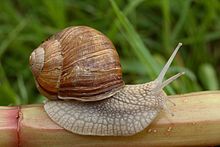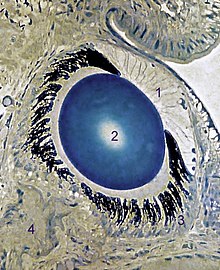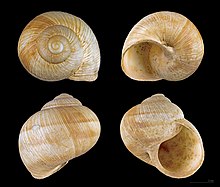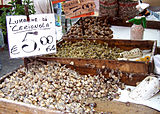
Helix is a genus of large, air-breathing land snails native to the western Palaearctic and characterized by a globular shell.

Cornu aspersum, known by the common name garden snail, is a species of land snail in the family Helicidae, which includes some of the most familiar land snails. Of all terrestrial molluscs, this species may well be the most widely known. It was classified under the name Helix aspersa for over two centuries, but the prevailing classification now places it in the genus Cornu.

An epiphragm is a temporary structure which can be created by many species of shelled, air-breathing land snails, terrestrial pulmonate gastropod mollusks. It can also be created by freshwater snails when temporary pools dry up.

Helicidae is a large, diverse family of western Palaearctic, medium to large-sized, air-breathing land snails, sometimes called the "typical snails." It includes some of the largest European land snails, several species are common in anthropogenic habitats, and some became invasive on other continents. A number of species in this family are valued as food items, including Cornu aspersum the brown or garden snail, and Helix pomatia. The biologies of these two species in particular have been thoroughly studied and documented.

Helix lucorum is a species of large, edible, air-breathing land snail, a terrestrial pulmonate gastropod mollusk in the family Helicidae, the typical snails.

Helix ceratina, the Corsican snail, is a species of air-breathing land snail, a terrestrial pulmonate gastropod mollusk in the family Helicidae, the typical snails.

A land snail is any of the numerous species of snail that live on land, as opposed to the sea snails and freshwater snails. Land snail is the common name for terrestrial gastropod mollusks that have shells. However, it is not always easy to say which species are terrestrial, because some are more or less amphibious between land and fresh water, and others are relatively amphibious between land and salt water.
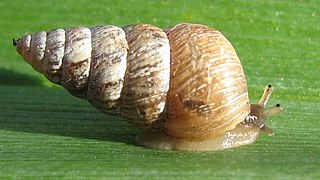
Cochlicella is a genus of small, narrow-shelled, air-breathing land snails, terrestrial pulmonate gastropod mollusks in the family Geomitridae, previously placed in the Helicidae, Cochlicellidae or Hygromiidae.
Helix nucula is a species of air-breathing land snail, a terrestrial pulmonate gastropod mollusk in the family Helicidae, the typical snails. It has a rounded shell with white aperture margins; it differs from the similar Helix figulina by fine spiral grooves on the upper shell surface. Previously, the name H. nucula was used also for Helix pronuba, an unrelated species occurring in North Africa and on Crete, creating some confusion in the literature.

Helix cincta is a species of gastropods belonging to the family Helicidae.

Helix borealis is a species of large, air-breathing land snail native to Greece and the south-west of Anatolia. It is characterized by brown to dark brown margins of the shell aperture. For decades, the species has been considered synonymous with Helix cincta.

Helix vladika is a species of large, air-breathing land snail native to Montenegro and Serbia. It has a brown, conical shell. It is the largest land snail species in Europe. Typical habitat are beech forests. The species is closely related to Helix straminea.
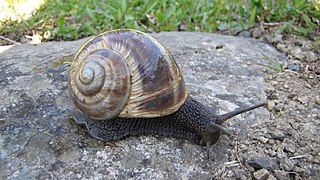
Helix buchii is a species of large, air-breathing land snail native to northeastern Turkey, Georgia, and northern Armenia.
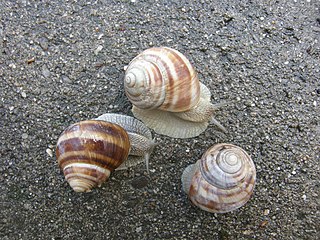
Helix dormitoris is a species of large, air-breathing land snail native to mountainous regions of Montenegro, eastern Bosnia and Herzegovina and western Serbia.
Maltzanella is a genus of terrestrial pulmonate gastropod mollusks in the family Helicidae, the typical snails. It has two known species distributed in Turkey. The shell is similar to Helix, which is the sister lineage to Maltzanella.

Helix thessalica is a species of large, air-breathing land snail native to Europe. It is externally similar to Helix pomatia, but has a dark grey penis and vagina. The species has been long considered synonymous with H. pomatia.
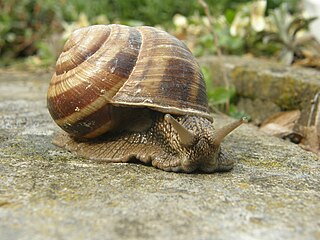
Helix straminea is a species of large, air-breathing land snail native to North Macedonia, Albania and Italy.
